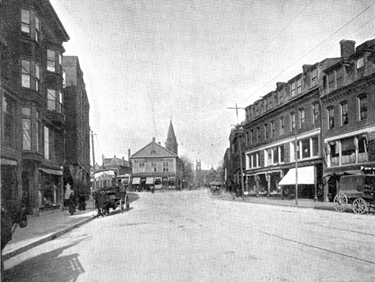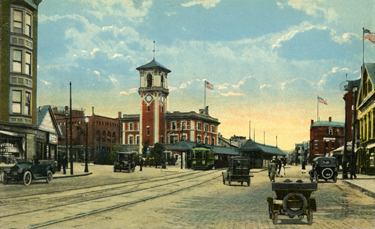Crossing the Muddy River was necessary for all westward travel out of Puritan Boston, so in 1639, a cart bridge was built over the river near the intersection of Huntington, Brookline Avenue, and Boylston Street. Brookline's first settlers, Bostonians with land grants for pasturing cattle, lived near this bridge on lower Washington Street. By 1650, there were 25 families living in Muddy River. Three main transportation routes were built soon after. The Sherburne road traveling west (Walnut, Warren, Boylston, and Heath Streets) was laid out in 1658. Harvard Street (the road to the colleges in Cambridge) was laid out in 1662. Washington Street (the road to Watertown) was laid in 1657. The center of town life was at the intersection of Walnut and Warren Streets around the old Town Green. The oldest and only 17th century house left in Brookline, which is dated 1650 and is today located on White Place, was probably moved there when White Place was laid out in 1848.
The Punch Bowl Tavern
Of primary importance to early community life was the Punch Bowl Tavern. Erected near Pearl Street in 1730, it served as a respite for British soldiers before the revolution, and later, in 1806, it became a stagecoach stop. 1806 was also the year construction began on the Worcester Turnpike (Route 9). The 1840's brought several major developments that changed the dynamics of the Village. A new Town Hall was built on Washington Street in 1844, and the railroad arrived in 1847. These changes, as well as a system of horse-drawn trolleys and a stagecoach stop, all conspired to relocate the focus of town life from the old Town Green area (Walnut and Warren Streets) to the Village. Rapid growth and change soon followed, with sections of land being divided and built upon in a pattern radiating from the commercial center, such as the Linden Place neighborhood and White Place. The Linden area, one of the first planned developments in Brookline, was designed in 1843-44 to be a "garden suburb," which meant that it was residential only, and other uses such as manufacturing were strictly prohibited. The garden suburb ideal of a country setting that is also within close proximity to city amenities, is one that is still sought after today. Boston merchants quickly filled the charming neighborhood. The narrow, curving roads and small pocket parks reflect the pre-automobile era of this development.
The Immigration Wave
Immigrants were beginning to arrive in Boston, and some of them came out to settle in Brookline Village, most notably those from Germany and Ireland. Several commercial enterprises began during the mid 1800's near Pearl and Boylston Streets, such as a blacksmith, livery stables, gas storage facilities, and carpenter and paint shops. Prior to the Civil War in 1861, most of the commercial development was to the south of the bridge. Charles Holtzer, a German immigrant, came to the United States in 1866 and built one of Brookline's few industries, on Station Street. The Holtzer-Cabot Company made bells, alarms, annunciators, telephone equipment, and small motors. The company also manufactured the first electric car made in America in 1891 for Brookline resident Fiske Warren. Brookline's foray into industrial production came and went fairly quickly. Holtzer moved to a larger plant in Boston in 1915.
After the Civil War, the wooden mansard commercial buildings on Washington Street were replaced with panel brick buildings that were to become the signature style in Brookline Village. Commercial development in this style expanded up Washington and Harvard Streets. The Y-shaped intersection of Harvard and Washington Streets formed a triangle that was named Harvard Square. Residential development filled neighborhoods surrounding the commercial streets, with a variety of house styles such as Queen Anne, Colonial Revival, and Shingle Style being built on Aspinwall, Kent, Cypress, Francis, Perry, and Gorham Streets. Triple-deckers were built along Boylston, Pearl, and Emerald Streets. A new Town Hall was built in 1870 on the site of today's Town Hall. Indicative of civic pride, the town built the country's first public baths and gymnasium on Tappan Street in 1896.
Park Creation
Brookline was the first suburban community to form a Park Board, and joining together with Boston, they hired F.L. Olmsted, who moved to Brookline in 1883 to undertake the creation of the Emerald Necklace park system. The Muddy River marshlands were transformed into the Riverway portion of the linear park system. Channeling and recontouring the river course diminished flooding and public health problems. The sculpting of the shorelines and meticulously planned plantings created a peaceful landscape conducive to recreational meanderings.
The members of the Davis family were early Brookline Village settlers who were very involved in town affairs. They built a house at the corner of Washington and Davis in 1760. Elijah Emerson, a prominent businessman, purchased some land from the Davis family, building a Gothic Revival house in 1846. He later subdivided his land and built ten homes that he rented out. In 1907, his surviving daughters moved the family home and sold its 2 acres of land to the town, thus creating the Emerson Garden Park.
Harvard Square, which today is defined by the distinctive scroll top façade on the building that sits at an angle, was transformed into its current incarnation sometime around the turn of the last century. The photo of the Village from the 1880's shows a Victorian Gothic building at the Square, which housed Harvard Hall. It was replaced by the early 1900's with the scroll top building that was designed by William C. Collett to house the Rhodes brothers' grocery business. Washington Street was widened in 1905.
The early, modest buildings on lower Washington Street were replaced during the 1960's era of urban renewal. This period also brought the replacement of Town Hall with the structure we have today.

